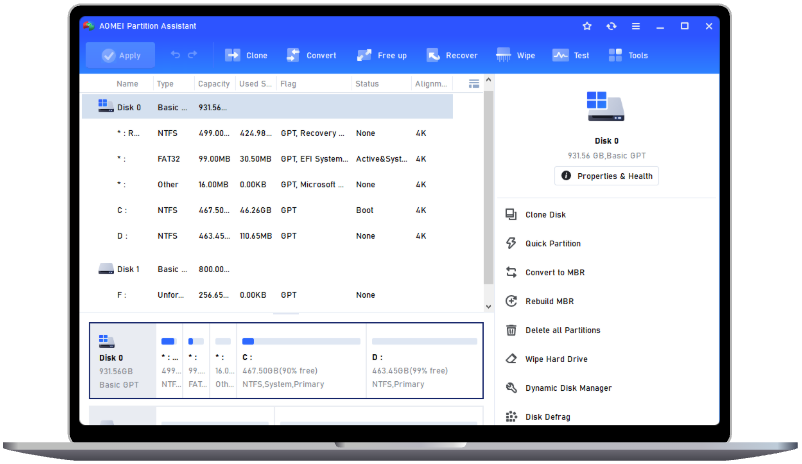How to Change Windows Sign in Password [4 Ways]
A Windows sign-in password is a security feature used to protect your computer and personal data. If you forget it or want to upgrade to a safer one, you can refer to this post to see how to change Windows sign in password with ease.
What is Windows sign in password?
A Windows sign-in password is a security measure used to protect your user account on a Windows operating system. It’s a password that you create when setting up your Windows account, and it’s required whenever you sign in to your computer. This password helps ensure that only authorized users can access the computer and its data.
You can set a computer password during the setup of your Windows account, or you can change it later in the settings.
Windows supports different types of sign-in methods:
• Local account password: A password created for a specific device, not linked to a Microsoft account.
• Microsoft account password: A password used for signing into Windows with a Microsoft account, allowing cloud synchronization and access to Microsoft services.
• PIN (Personal Identification Number): A shorter, numeric or alphanumeric code used instead of a password.
• Windows Hello: A biometric authentication method using fingerprint, facial recognition, or a security key.
• Picture password: A unique password where you use gestures on an image to sign in (available on some older Windows versions).
How to change Windows sign in password on Windows 11/10
Changing your Windows sign-in password is essential for security, whether you want to update an old password or reset a forgotten one. If you are using a Microsoft account password, you can directly go to the Microsoft password reset page to change it. If you are a local user, here are four simple methods to do it.
Method 1. Change sign in password with Windows Settings
Updating the sign in password in Windows 10 is a straightforward process that enhances both security and user convenience. By navigating through the system settings, users can easily modify the hint, ensuring it remains relevant and useful for password recovery while maintaining account protection.
Step 1. Open the Windows Settings, then click the "Accounts" option.
Step 2. Click "Sign-in options" tab and click "Change" under the "Password" section.
Step 3. In the new window, input the current password and click "Next".
Step 4. Input the new passwords and click "Next".
Method 2. Change Windows sign in password using Ctrl + Alt + Delete
The Ctrl + Alt + Delete shortcut offers a fast and direct way to update your password without digging through various settings. This method is especially convenient when you're already signed in and need to change your password quickly and efficiently.
Step 1. When logging into the system with the current password, press the "Ctrl + Alt + Del" keys at the same time.
Step 2. Select "Change a password" on the new screen.
Step 3. Enter your old password, leave the "Current password" and "Confirm password" boxes empty, and press "Enter".
Step 4. Then, every time when you log in, you can get in without typing the password.
Method 3. Change sign in password Windows via Command Prompt
For experienced users, the Command Prompt provides a fast and efficient way to change a password. This approach is especially handy when handling multiple user accounts or troubleshooting issues with the graphical interface.
Step 1. Type cmd into the Start menu, right-click the Command Prompt from the list, and choose Run as administrator.
Step 2. Type the command: net user and press Enter to list all the user account on your Windows system. Please note the account name you plan to change the password for.
Step 3. Type the "net user username new_password" and press the Enter key to continue. Remember to replace username and new_password with the actual username and new password for the account like net user admin 123456.
After that, you'll see a line saying the command was completed successfully. It means you have changed the password using CMD successfully. And then you can use the new password to log in to your account.
Method 4. Reset forgotten Windows sign in password
If you forget your password and the sign-in options don’t help, Windows 10 offers multiple recovery methods. A password reset disk is a popular one, but if that fails, AOMEI Partition Assistant provides a reliable alternative.
With its user-friendly interface, this powerful tool simplifies the password reset process, allowing you to regain access to your PC quickly. By creating a bootable USB, you can reset your Windows password effortlessly and restore control over your system in just a few steps.
AOMEI Partition Assistant supports Windows 11/10/8/8.1/7. For users working with Windows Server, the Server Edition is available for seamless password recovery.
Step 1. Connect a prepared USB to any running computer. Install and launch AOMEI Partition Assistant. In the taskbar, click "Tools"> "Reset Windows Password".
Step 2. In the pop-up window, you'll be noted to create a WinPE bootable media. Click "Next" to move on.
Step 3. Here we tick "USB Boot Device", choose your prepared USB for bootable USB creation, and click "Proceed".
Step 4. Note that the USB flash drive needs to be formatted and all data on it will be wiped. Please back up anything important on it and redo it.
Step 5. Boot the computer from this bootable USB, and you will see AOMEI Partition Assistant on the screen. Click "Reset Password", select the Windows system you would like to operate, and click "Next".
Step 6. Then, select the account you would like to operate, choose a feature: "Remove Account Password" or "Reset Account Password", and click "Next".
Step 7. Next, a pop-out window lets you set a new password. After you confirm the new password, please click "Yes" to start the password reset/remove.
Conclusion
That’s all about how to change Windows sign in password on Windows 11/10. Changing it is a straightforward task that enhances security and helps you recall your password more easily. By following the simple steps in this guide, you can adjust your password hint to ensure it remains effective. Additionally, we provide solutions for cases when you forget your password.
Beyond its password resetting capabilities, AOMEI Partition Assistant offers a variety of features designed to improve your computing experience. These include migrating your OS to a new hard drive, transferring installed programs, wiping hard drives, and more.


